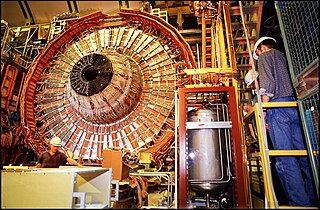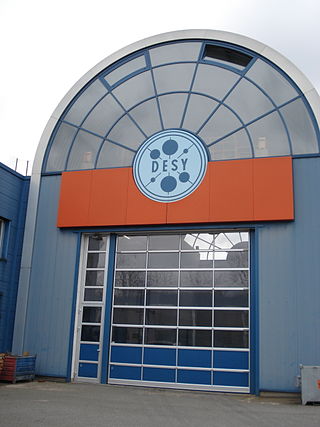Related Research Articles


ATLAS is the largest general-purpose particle detector experiment at the Large Hadron Collider (LHC), a particle accelerator at CERN in Switzerland. The experiment is designed to take advantage of the unprecedented energy available at the LHC and observe phenomena that involve highly massive particles which were not observable using earlier lower-energy accelerators. ATLAS was one of the two LHC experiments involved in the discovery of the Higgs boson in July 2012. It was also designed to search for evidence of theories of particle physics beyond the Standard Model.

Air showers are extensive cascades of subatomic particles and ionized nuclei, produced in the atmosphere when a primary cosmic ray enters the atmosphere. When a particle of the cosmic radiation, which could be a proton, a nucleus, an electron, a photon, or (rarely) a positron, interacts with the nucleus of a molecule in the atmosphere, it produces a vast number of secondary particles, which make up the shower. In the first interactions of the cascade especially hadrons are produced and decay rapidly in the air, producing other particles and electromagnetic radiation, which are part of the shower components. Depending on the energy of the cosmic ray, the detectable size of the shower can reach several kilometers in diameter.

DELPHI was one of the four main detectors of the Large Electron–Positron Collider (LEP) at CERN, one of the largest particle accelerators ever made. Like the other three detectors, it recorded and analyzed the result of the collision between LEP's colliding particle beams. The specific focus of DELPHI was on particle identification, three-dimensional information, high granularity (detail), and precise vertex determination.
Particle identification is the process of using information left by a particle passing through a particle detector to identify the type of particle. Particle identification reduces backgrounds and improves measurement resolutions, and is essential to many analyses at particle detectors.

The Collider Detector at Fermilab (CDF) experimental collaboration studies high energy particle collisions from the Tevatron, the world's former highest-energy particle accelerator. The goal is to discover the identity and properties of the particles that make up the universe and to understand the forces and interactions between those particles.

In particle physics, a shower is a cascade of secondary particles produced as the result of a high-energy particle interacting with dense matter. The incoming particle interacts, producing multiple new particles with lesser energy; each of these then interacts, in the same way, a process that continues until many thousands, millions, or even billions of low-energy particles are produced. These are then stopped in the matter and absorbed.

The DØ experiment was a worldwide collaboration of scientists conducting research on the fundamental nature of matter. DØ was one of two major experiments located at the Tevatron Collider at Fermilab in Batavia, Illinois. The Tevatron was the world's highest-energy accelerator from 1983 until 2009, when its energy was surpassed by the Large Hadron Collider. The DØ experiment stopped taking data in 2011, when the Tevatron shut down, but data analysis is still ongoing. The DØ detector is preserved in Fermilab's DØ Assembly Building as part of a historical exhibit for public tours.

ZEUS was a particle detector at the HERA particle accelerator at the German national laboratory DESY in Hamburg. It began taking data in 1992 and was operated until HERA was decommissioned in June 2007. The scientific collaboration behind ZEUS consisted of about 400 physicists and technicians from 56 institutes in 17 countries.
Cryogenic particle detectors operate at very low temperature, typically only a few degrees above absolute zero. These sensors interact with an energetic elementary particle and deliver a signal that can be related to the type of particle and the nature of the interaction. While many types of particle detectors might be operated with improved performance at cryogenic temperatures, this term generally refers to types that take advantage of special effects or properties occurring only at low temperature.

A neutrino detector is a physics apparatus which is designed to study neutrinos. Because neutrinos only weakly interact with other particles of matter, neutrino detectors must be very large to detect a significant number of neutrinos. Neutrino detectors are often built underground, to isolate the detector from cosmic rays and other background radiation. The field of neutrino astronomy is still very much in its infancy – the only confirmed extraterrestrial sources as of 2018 are the Sun and the supernova 1987A in the nearby Large Magellanic Cloud. Another likely source is the blazar TXS 0506+056 about 3.7 billion light years away. Neutrino observatories will "give astronomers fresh eyes with which to study the universe".

The Mainz Microtron, abbreviated MAMI, is a microtron which provides a continuous wave, high intensity, polarized electron beam with an energy up to 1.6 GeV. MAMI is the core of an experimental facility for particle, nuclear and X-ray radiation physics at the Johannes Gutenberg University in Mainz (Germany). It is one of the largest campus-based accelerator facilities for basic research in Europe. The experiments at MAMI are performed by about 200 physicists of many countries organized in international collaborations.
In particle physics, a hermetic detector is a particle detector designed to observe all possible decay products of an interaction between subatomic particles in a collider by covering as large an area around the interaction point as possible and incorporating multiple types of sub-detectors. They are typically roughly cylindrical, with different types of detectors wrapped around each other in concentric layers; each detector type specializes in particular particles so that almost any particle will be detected and identified. Such detectors are called "hermetic" because they are constructed so as the motion of particles are ceased at the boundaries of the chamber without any moving beyond due to the seals; the name "4π detector" comes from the fact that such detectors are designed to cover nearly all of the 4π steradians of solid angle around the interaction point; in terms of the standard coordinate system used in collider physics, this is equivalent to coverage of the entire range of azimuthal angle and pseudorapidity. In practice, particles with pseudorapidity above a certain threshold cannot be measured since they are too nearly parallel to the beamline and can thus pass through the detector. This limit on the pseudorapidity ranges which can be observed forms part of the acceptance of the detector ; broadly speaking, the main design objective of a hermetic detector is to maximise acceptance, i.e. to ensure that the detector is able to measure as large a phase space region as possible.
The Molière radius is a characteristic constant of a material giving the scale of the transverse dimension of the fully contained electromagnetic showers initiated by an incident high energy electron or photon. By definition, it is the radius of a cylinder containing on average 90% of the shower's energy deposition. Two Molière radii contain 95% of the shower's energy deposition. It is related to the radiation length X0 by the approximate relation RM = 0.0265 X0 (Z + 1.2), where Z is the atomic number. The Molière radius is useful in experimental particle physics in the design of calorimeters: a smaller Molière radius means better shower position resolution, and better shower separation due to a smaller degree of shower overlaps.
ALEPH was a particle detector at the Large Electron-Positron collider (LEP) at CERN. It was designed to explore the physics predicted by the Standard Model and to search for physics beyond it.

The L3 experiment was one of the four large detectors on the Large Electron–Positron Collider (LEP). The detector was designed to look for the physics of the Standard Model and beyond. It started up in 1989 and stopped taking data in November 2000 to make room for construction of the Large Hadron Collider (LHC). Now, the ALICE detector sits in the cavern that L3 used to occupy, reusing L3's characteristic red octagonal magnet.
The CALICE collaboration is an R&D group of more than 280 physicists and engineers from around the world, working together to develop new, high performance detectors for high energy positron-electron experiments at future International Linear Collider (ILC). It is a part of the European EUDET project.
Cosmic Ray Energetics and Mass (CREAM) is an experiment to determine the composition of cosmic rays up to the 1015 eV (also known as the "knee prospect") in the cosmic ray spectrum.
References
- ↑ Particle Physics Booklet 2006 pg 272